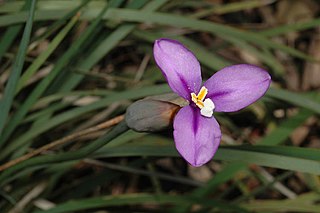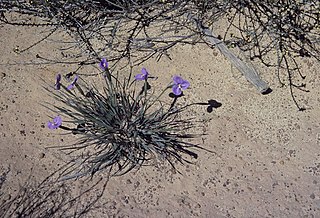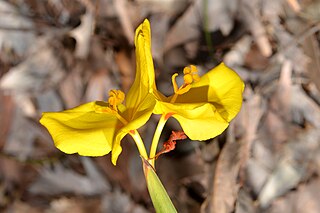
Patersonia, is a genus of plants whose species are commonly known as native iris or native flag and are native to areas from Malesia to Australia.

Prostanthera lasianthos, commonly known as the Victorian Christmas bush or coranderrk , is a large shrub or small tree of the mint family, Lamiaceae, which is native to Queensland, New South Wales, Victoria and Tasmania in Australia. It grows up to 10 m (35 ft) high but is usually much less and is found in wet sclerophyll forests, often beside creeks. Its flowers, which appear in profuse sprays, are about 2 cm long and white or pale lilac, with purple and orange blotches in the throat. They appear in late spring and summer, and specifically around Christmas time in Victoria. The fragrant, toothed leaves are 4 to 12 cm long and about 1.5 cm wide.

Utricularia dichotoma, commonly known as fairy aprons, is a variable, perennial species of terrestrial bladderwort. It is a widespread species with mauve or purple fan-shaped flowers on a slender stalk and usually grows in wet locations.
Patersonia maxwellii is a species of flowering plant in the iris family Iridaceae and is endemic to the south of Western Australia. It is a tufted, rhizome-forming perennial herb with linear leaves and violet tepals.

Olearia ramulosa, commonly known as twiggy daisy-bush, is a species of flowering plant in the family Asteraceae and is endemic to south-eastern Australia. It is a shrub with narrowly elliptic, linear or narrowly egg-shaped leaves, and pale blue, mauve or white and yellow, daisy-like inflorescences.

Comesperma volubile, commonly known as love creeper, is a slender climber in the family Polygalaceae. It is a twining plant with linear leaves and pea-like blue flowers.

Persoonia juniperina, commonly known as prickly geebung, is a species of flowering plant in the family Proteaceae and is endemic to south-eastern Australia. It is a small erect to low-lying shrub with smooth bark, hairy new branches, linear leaves, yellow flowers borne singly or in groups of up to forty in leaf axils, and yellowish green to purplish fruit.

Patersonia sericea, commonly known as purple flag or silky purple-flag is a species of plant in the iris family Iridaceae and is endemic to eastern Australia. It is a densely-tufted perennial herb with linear, sword-shaped leaves, broadly egg-shaped, bluish-violet tepals and an oval capsule.

Patersonia occidentalis, commonly known as purple flag, or long purple-flag, is a species of flowering plant in the family Iridaceae and is endemic to southern Australia. It is a tufted, rhizome-forming perennial with narrow, sharply-pointed, strap-like leaves, egg-shaped, bluish violet sepals and a cylindrical capsule. The Noongar name for the plant is komma.

Gaudium glaucescens, commonly known as the blue-green tea tree or smoky tea tree, is a species of shrub or small tree that is endemic to Tasmania. It has elliptical to egg-shaped leaves that are often greyish green, white flowers about 15 mm (0.59 in) in diameter arranged in consecutive leaf axils and fruit that remain on the plant for some time after maturity.
Patersonia borneensis is a species of plant in the iris family Iridaceae and is endemic to a restricted area of Borneo. It is a tufted perennial with many leaves and pale lavender to bluish-purple tepals on a flowering stem shorter than the leaves.

Patersonia drummondii, commonly known as Drummond's patersonia, is a species of plant in the iris family Iridaceae and is endemic to the south-west of Western Australia. It is a tufted herb with linear, often twisted leaves and pale violet to purple or blue tepals.

Patersonia glabrata, commonly known as leafy purple-flag, or bugulbi in the Cadigal language, is a species of flowering plant in the family Iridaceae and is endemic to eastern Australia. It is a perennial herb or subshrub with linear leaves and pale violet flowers.

Patersonia graminea, commonly known as grass-leaved patersonia, is a species of plant in the iris family Iridaceae and is endemic to the south-west of Western Australia. It is a clump-forming herb with linear, grass-like leaves and pale violet tepals.
Patersonia juncea, commonly known as rush leaved patersonia, is a species of plant in the iris family Iridaceae and is endemic to a restricted part of the south-west of Western Australia. It is a tufted perennial herb with linear leaves and pale violet tepals.

Patersonia lanata, commonly known as woolly patersonia, is a species of flowering plant in the family Iridaceae and is endemic to the south of Western Australia. It is a tufted perennial herb with sword-shaped leaves and blue-violet flowers.
Patersonia limbata is a species of plant in the iris family Iridaceae and is endemic to the south of Western Australia. It is a tufted, rhizome-forming herb with sword-shaped, bordered leaves and violet tepals.

Patersonia macrantha is a species of plant in the iris family Iridaceae and is endemic to the northern part of the Northern Territory. It is a tuft-forming herb with linear to sword-shaped leaves and pale violet tepals.
Patersonia pygmaea is a species of plant in the iris family Iridaceae and is endemic to the south-west of Western Australia. It is a tufted, rhizome-forming perennial herb with sword-shaped leaves and bluish-violet to purple tepals.

Patersonia umbrosa, commonly known as yellow flags, is a species of plant in the iris family Iridaceae and is endemic to the south-west of Western Australia. It is a loosely-tufted, rhizome-forming, perennial herb with linear to sword-shaped leaves and deep bluish-violet or bright yellow tepals.















